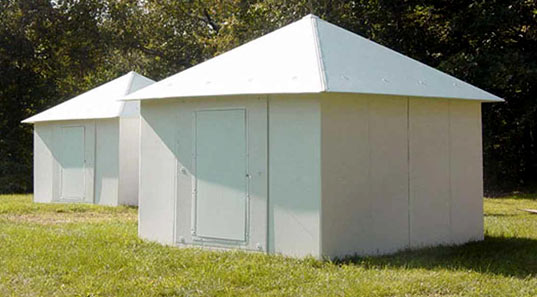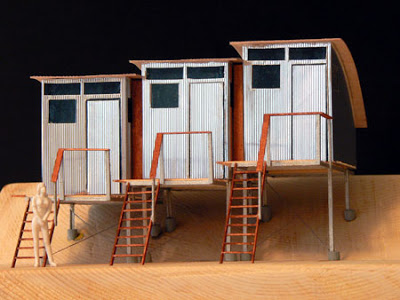For a really good selection of small houses and sheds which have not been proposed as solutions for shelter in emergencies, see the excellent www.readersheds.co.uk and cabinporn.com.
Better shelter
The Better Shelter, previously known as the ‘Refugee Housing Unit’ costs $1250 US, weighs 140kg and has a covered area of 17.5m2. For an average family of 5 this provides 3.5m2 per person.
“Better Shelter is a weatherproof and socially sustainable temporary shelter. It offers a more dignified home for displaced people and a more cost-effective solution for humanitarian organizations.”
The Better Shelter is arguably the culmination of the project to develop transitional shelter prototypes, but because of the backing from UNHCR has also indirectly stifled development of competitor products. UNHCR has bought 10,000 of the shelters and used them for refugees in North Africa, the Middle East and in Europe. To my knowledge there are as yet no independent evaluations of these programmes. Personally, I would rather be in these than in a tent, which is not something I can say about many of the inventions on these pages, but there is of course a lot more to it than that (personally I’d rather be in a large, luxurious private house too).
The cost is well beyond the normal budget of most shelter actors. Whether the Better Shelter will be a success, or will be widely used by any agency other than UNHCR, remains to be seen, and should perhaps be put in light of UNHCR’s own Global Strategy for Settlement & Shelter:
“Shelter should be adapted according to geographical context, climate, cultural practices and habits, local availability of skills within the affected population at large as well as accessibility to adequate construction materials in any given country. Shelter assistance should, therefore, be tailored around these variables. It cannot be standardized. Planning and responding to shelter needs is a contextual and dynamic process. “
Some others’ thoughts on this are:
http://www.techinsider.io/ikea-better-shelter-for-refugees-photos-2015-11
AGA houses
“The houses are colorful (as in the first photo), waterproof and buoyant. They can be used inside another structure or outdoors and after use can be stored until another disaster strikes. In a water-related crisis, locating the boxes is easier because of the bright colors and their ability to float (they can also double as rafts). When not in use, each can be stored in a box that’s about 5 by 6 feet (1½ by 2 meters) that can be used as a table.”
Almost comically small, it’s hard to believe anyone would seriously propose these. I can only hope the title of the article linked to below is ironic.
Global Village Shelters
The smaller global village shelter costs $550 US and provides 6.2m2 of covered space. For an average family of 5 this provides 1.24m2 per person.
“A virtual origami house, the Global Village Shelter is made with large sheets of fold-up corrugated laminated cardboard, flat-packed in three easily shippable parts. The prejointed walls simply have to be unfolded, and two roof pieces connected and placed on top. It’s light and simple enough to be constructed by two people in less than an hour. And at $550 bucks a pop, this is truly affordable prefab.”
“the designer Mia Ferrara, specifically says the shelter was designed to have a limited shelf-life: “Structures meant to be temporary can often remain in use for years after a disaster, leading to problems associated with poverty. The temporary nature of the Global Village Shelter does not allow for this.”
It is a valuable insight to recognise that temporary shelters provided after emergencies more often than not end up being permanent, sub-standard housing. However, I question the rationale of spending $550 on something that cannot last (plus all the costs of shipping), rather than spending that money on something actually durable; many disaster-stricken people could go a long way to building a permanent house with $550.

http://www.ferraradesign.com/#!__global-village-shelter
http://inhabitat.com/prefab-friday-global-village-shelters/
http://www.designother90.org/solution/global-village-shelter/
Studio D
“Whether by war or natural disaster, when thousands of homeless people need reliable, cheap, portable shelter, temporary emergency structures may provide simple, easily assembled and biodegradable solutions. In addition to putting a roof over a person’s head, this emergency shelter provides storage for some personal belongings, some privacy, and a clearly delineated sense of personal place for each user.”
Not much information available on this one, but there’s one comment on the website linked to below: “Looks like my Grandma’s outhouse”. Quite.

http://www.shedworking.co.uk/2009/01/studio-d-temporary-habitat.html
